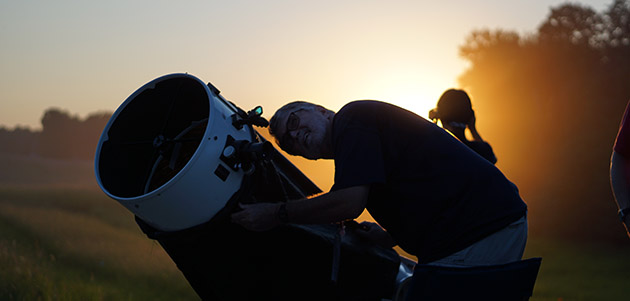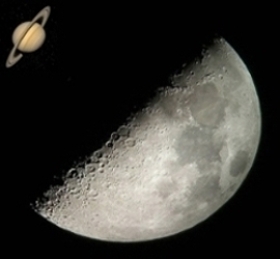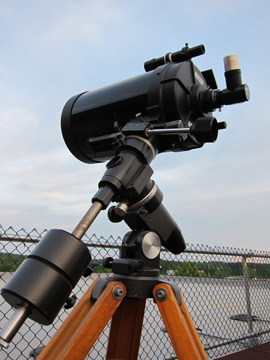
Public Astronomy Observations
Observation Schedule Fall 2025
Sunday, August 17, 9 – 10:30pm
Free public astronomy observation at the Southern Illinois University Carbondale, School of Physics and Applied Physics Astronomy Observation Deck, located on the roof of the Neckers building at 1245 Lincoln Drive. Join SIU Physics and the Astronomical Association of Southern Illinois for an evening of guided telescopic observations of the night sky.
Significant objects visible this evening: Saturn - rising at 9:21 pm, M57 (Ring Nebula) and M13 (Hercules Globular Cluster).
Children accompanied by adults are welcome. Please note that the observation deck is not handicap accessible and is only accessible via stairs. Note that while this is an outdoor activity, you may be in close proximity to people throughout the evening. Masks for this event are optional.
All observations are weather dependent. For more information, visit https://physics.siu.edu/events/astronomy.php
Saturday, September 27. – Southern Illinois Star Party. 5pm – 11pm
Join SIU Carbondale and the Astronomical Association of Southern Illinois for a free night of guided telescope observations as well as family friendly astronomy and science activities. Enjoy an evening under the stars at the SIU University Farms Astronomy Observation Area. The site is 2 miles west of SIU’s main campus in a semi-dark area that offers good views of the night sky.Several night time and solar telescopes operated by amateur astronomers and SIU School of Physics and Applied Physics faculty, staff, and students will be available to the public this evening.
Visitors will be able to see the Sun, Moon, Venus, Saturn, Jupiter and other celestial objects.Visitors are welcome to bring their own lawn chairs and blankets as well as photography or telescope equipment. Free shuttles will run from SIU Parking lot #63 at the corner of Oakland and Chautauqua streets throughout the evening. Parking at the SIU Farms observation site is very limited and available by permit only.
For disability accommodations call 618-453-5738. Disabled visitors or those bringing telescope equipment that would be difficult to transport by shuttle may contact events@siu.edu or call SIU Events and Outreach at 618-453-7751 for a free onsite parking permitSee https://eclipse.siu.edu/southern-Illinois-star-party/ for more details.
Saturday, October 5, 7:30pm – 9:00pm
Free public astronomy observation at the Southern Illinois University Carbondale, School of Physics and Applied Physics Astronomy Observation Deck, located on the roof of the Neckers building at 1245 Lincoln Drive. Join SIU Physics and the Astronomical Association of Southern Illinois for an evening of guided telescopic observations of the night sky.
Significant objects visible this evening: Saturn, the Moon, M57 (Ring Nebula) and M13 (Hercules Globular Cluster).
Children accompanied by adults are welcome. Please note that the observation deck is not handicap accessible and is only accessible via stairs. Note that while this is an outdoor activity, you may be in close proximity to people throughout the evening. Masks for this event are optional.
All observations are weather dependent. For more information, visit https://physics.siu.edu/events/astronomy.ph
Sunday, November 16, 9pm – 10:30
Free public astronomy observation at the Southern Illinois University Carbondale, School of Physics and Applied Physics Astronomy Observation Deck, located on the roof of the Neckers building at 1245 Lincoln Drive. Join SIU Physics and the Astronomical Association of Southern Illinois for an evening of guided telescopic observations of the night sky.
Significant objects visible this evening: Saturn, Jupiter, M42 (Great Orion Nebula) and M31 (the Andromeda galaxy)
Children accompanied by adults are welcome. Please note that the observation deck is not handicap accessible and is only accessible via stairs. Note that while this is an outdoor activity, you may be in close proximity to people throughout the evening. Masks for this event are optional.
All observations are weather dependent. For more information, visit https://physics.siu.edu/events/astronomy.ph
Observation Deck and Telescopes
The observation deck is 624 square feet in size. It is built out of 2" thick rubber matting for vibration isolation. The primary telescope is a 14" Meade LX600. This computer guided telescope is used for all observation events as well as the lab portion of PHYS 103 (Astronomy). Several additional scopes are setup for observations as needed including Celestron 8" SCTs, a Coronado SolarMax II, and a Stellarvue SV105 Raptor (105mm refractor).
What Can You See?

The most spectacular viewing is of the Moon and major planets such as Jupiter, Saturn, Venus and Mars. On clear nights, you can easily see the rings of Saturn and detailed striations on Jupiter. Brighter objects such as the Great Orion Nebula, the Andromeda Galaxy and several clusters are also visible visually.
Dimmer deep sky objects are typically only visible during evenings with low humidity and not much cloud cover. On select night, deep sky cameras are utilized to display images of objects otherwise not visible though visual observations.
Bringing a Group to aPublic Observation
Groups in excess of 10 visitors should contact rbaer@siu.edu in advance of your visit to insure adequate space for your group.
Previous Event Photos
Mars Opposition Star Party 2018. Star party at the SIU Farms for the Mars Opposition. See photos of the event on Bob Baer's Flickr photo stream.
April 4 - 8, 2024 for four days of eclipse theme events capped off by Eclipse Day at Saluki Stadium. Check out the photos at: eclipse.siu.edu



